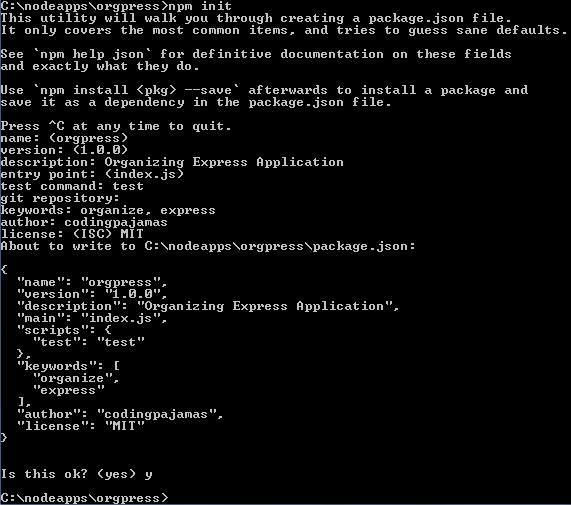
Introduction
Fast, unopinionated, minimalist web framework for Node.js
ExpressJS is one of the easier and more popular nodejs framework out there and you can find numerous blogs and tutorials in the internet.
Problem
Because express is an unopinionated framework, almost every tutorial in the internet does the same thing in different way which confuses beginners specially in organizing their express application.
Solution
In this article we will follow a MVCish style where we have a model folder for our mongo schemas, a views folder for our templates and a routes folder for our routes which are going to act as our controllers. Also an index.js file as entry point to our express application. So let’s start.
1. Intall ExpressJS
Open your terminal and create orgpress directory then cd to it. Yes, I can’t think of a better app name than combining organize express into orgpress. And yes again, im on windows.
mkdir orgpress
cd orgpress
Create package.json by typing npm init and then fillup the terminal wizzard with the details for our application. Please refer to the image below.

Install express and register it in package.json as a dependency.
npm install express --save
We also need to install some of the most common modules used in express applications.
For our templating engine, we will use jade.
npm install jade --save
An odm which will help us in mongodb, I usualy use mongoose
npm install mongoose --save
body-parseris a node.js body parsing middleware
npm install body-parser --save
After installing these modules successfully, we’re now ready to create our express application.
2. Creating the files and sub-folders
Let’s create our orgpress file structure.
/orgpress
/config
db.js
/models
blog.js
store.js
/node_modules
/public
/css
/js
/images
/routes
blogs.js
index.js
stores.js
/views
/blogs
index.js
/stores
index.js
index.js
package.json
This is how I organize my express 4 application.
The /config folder contains all configuration files such as the database config in db.js.
The /models folder contains our mongoose schemas.
The /node_modules is where our dependency modules reside.
The /public folder is where our assets like css, javascript and image files go.
The /routes folder will contains our route files.
The /views folder contains our template files. We created sub-folders to group the templates based on their types (or based on available schemas).
The index.js is the heart of express application and it is composed of 5 parts:
- Include dependencies
- Set configurations
- Create the custom middlewares
- Declare routes
- Start express application
3. Creating express application
3.a Include the dependencies
When creating an express application, the first part is adding your dependencies specially the express module.
// declare dependencies
var express = require('express');
var app = express();
var path = require('path');
var bodyParser = require('body-parser');
var mongoose = require('mongoose');
In the chunk of code above, we required express in our application and stored it in a variable. Then we invoked it with express() to exposed its APIs and saved it to app variable.
We also required the path, bodyParser, mongoose modules.
3.b Setup configurations
// configurations
app.set('views', path.join(__dirname, 'views'));
app.set('views engine', 'jade');
app.use(bodyParser.json());
app.use(bodyParser.urlencoded({ extended: false }));
app.use(cookieParser());
app.use(express.static(path.join(__dirname, 'public')));
require('./config/db')(mongoose); /* database configuration */
Basically, we’re configuring express settings using app.set(). You can find more properties to configure at express docs. And we use app.use to configure the middlewares from our dependency modules.
If you noticed we didn’t required jade when we’re including our application dependencies but we’re using it in the configuration by setting it as a value of views engine, that’s because express imported it already behind the scene (but you still need to install jade module locally).
And lastly, we configure mongoose to connect to mongodb by requiring the file (or in this case a module) db.js inside the /config folder and passed the mongoose object.
This is what our database configuration looks like.
// '/config/db.js'
module.exports = function(mongoose) {
var dbURI = 'mongodb://localhost/orgpress';
mongoose.connect(dbURI);
mongoose.connection.on('connect', function(){
console.log('Mongoose connected on ' + dbURI);
});
mongoose.connection.on('error', function(err){
console.log('Mongoose connection : ' + err);
});
}
3.b Creating the routes
This is where most of the beginners get confused, structuring routes. Normally routes can be created in the index.js file but as your application grows bigger, it’ll get ugly. I’ve seen different ways but the cleanest is the middleware style of routing.
First we include the routes in our express application:
// call routes
require('./routes')(app);
So let’s create a routes folder which has an index.js as entry point. Then inside our index.js, we will call our other route files.
Inside /routes/index.js
// '/routes/index.js'
module.exports = function (app) {
app.use('/blogs', require('./blogs'));
app.use('/stores', require('./stores'));
//and some other route files if you have more...
};
Inside /routes/blogs.js
// '/routes/blogs.js'
var express = require('express');
var router = express.Router();
var Blog = require('../models/blog');
router.get('/', function(req, res){
Blog.find({},{},{}, function(err, blogs){
if(!err){
res.render('blogs/index.jade', {});
} else {
res.send(err);
}
});
});
module.exports = router;
And let’s create /routes/users.js too.
// '/routes/stores.js'
var express = require('express');
var router = express.Router();
var Store = require('../models/store');
router.get('/', function(req, res){
Store.find({},{},{}, function(err, stores){
if(!err){
res.render('stores/index.jade', {});
} else {
res.send(err);
}
});
});
module.exports = router;
3.c The models
As you can see in /routes/blog.js, we required the ../models/blog. So let’s create our blog schema.
// '/models/blog.js'
var mongoose = require('mongoose');
var blogSchema = new mongoose.Schema({
title: String,
body: String,
category: String,
createdOn: {type: Date, default: Date.now()},
modifiedOn: {type: Date}
});
module.exports = mongoose.model('Blog', blogSchema);
You might be wondering (and worrying maybe) why we have to do mongoose = require('mongoose') again, we already did that in the main index.js. Don’t worry about that because require will return the same mongoose object, it didn’t instantiate the module twice.
Let’s create the store schema too since we create a controller for stores.
// '/models/store.js'
var mongoose = require('mongoose');
var storeSchema = new mongoose.Schema({
name: String,
location : String,
owner: String
});
module.exports = mongoose.model('Store', storeSchema);
3.d The views
Let’s create a very simple view for the sake of having a complete express application. So in the views folder let’s create 2 folders, blogs and stores, and each directory will have an index.jade file.
Our blog template at /views/blogs/index.jade.
h1
| Welcome to my blog
Our store template at /views/stores/index.jade.
h1
| Welcome to my store
Yes, our template’s code are simple and clean. That’s jade syntax for you, you can learn more about jade syntax in their website
3.e Start our expressjs application
In order to start express, we just need to listen to listen to a port.
// start app
var port = process.env.PORT || 3000;
app.listen(port, function(){
console.log('Listening to port ' + port);
})
Now go to your terminal, make sure that mongod is active, and run node index. Then browse to http://localhost:3000/stores to test your expressjs v.4.x application.
Done!
This is not the only way of organizing your express application but this works for me and it’s simply well organized. There’s also an express generator which was reserved for another post. Thank you for reading.
